Combating Salt Water Intrusion Across the USA
Combating Salt Water Intrusion Across the USA
Salt Water Intrusion is a concerning phenomenon observed across the USA, affecting areas from the Ohio Valley to New Orleans, the Carolinas, and Florida. This process sees saline water from the ocean seeping into freshwater sources, compromising the quality and safety of water that communities rely on for drinking and other household uses. If you find yourself asking, “Is my water safe to drink?” due to saltwater intrusion in your area, this article provides insights and solutions to ensure access to safe drinking water, spotlighting the critical role of reverse osmosis systems in addressing saltwater contamination.
This Summer, the Ohio Valley experienced a significant drought, affecting the Mississippi River around New Orleans, Louisiana. The result is a notable instance of salt water intrusion - what is being referred to as the “Saltwater Wedge” - where ocean saltwater has intruded, adding a considerable amount of sodium to the water supplies intake. When salt water intrusion occurs, many individuals are left wondering, “Is my water safe to drink?” Humans and most animals cannot consume salt water since excreting the salt requires more water than initially ingested, leading to dehydration and serious health risks.
Although predicting the duration and future occurrences of salt water intrusion is challenging, effective solutions are available for those in affected areas. As a Master Water Specialist with 50 years of experience, I can assure you that reverse osmosis (RO) is a reliable method for resolving issues related to salt water intrusion.
This is not just something that is happening near New Orleans but we also see it happen on the Eastern Seaboard, around the Carolinas and all the way down into Florida. Currently, we are hearing about a “Saltwater Wedge” in New Orleans and WWNO (Public Radio) has a great article that answers questions related to this. What follows is from WWNO Radio
- What Can I do About the Saltwater Wedge?
- What is a saltwater wedge? Why is it happening?
- Has this happened before?
- Just how salty is this wedge?
- How long will it take...
- Could it affect people beyond Jefferson Parish?
- Will people in Jefferson, Orleans and St. Bernard lose...
- Should I prepare? If so, how?
- Will schools have to close?
- Would drinking saltier water hurt my health?
- Can I bathe and brush my teeth with salty water?
- Can we filter the salt out at home?
- Salt water is corrosive. How could this affect...
- The river is low. Can I take a swim?
- Can I garden with the water?
- How much rain is needed to push the saltwater wedge back?
- How often should we expect this type of saltwater intrusion...
- What's the Solution?
- LET THE BUYER BEWARE
- US Water Systems Reverse Osmosis Lineup
- A Heavy Duty Pump That Lasts
- The world's oceans...
- Solutions and the Path Ahead:
What is a saltwater wedge? Why is it happening?
The entire Mississippi River Valley is in a historic drought, so far less water is flowing down the river than usual. When that happens, salt water from the ocean can migrate upriver along the river's bottom, which is below sea level throughout the entire length of Louisiana. The denser salt water sinks beneath the river's freshwater during periods of low flow and slowly pushes north.
Has this happened before?
Yes. Salt water intrudes up the Mississippi River about once every decade. It happened in 2012 and again in 2022. The ocean water usually doesn't come this far north, but it isn't unprecedented. The salt water reached Kenner in 1988, but only stuck around for a few days before retreating. This year, the intrusion has the potential to last weeks. It's also unusual for this phenomenon to occur in back-to-back years.
Just how salty is this wedge?
Well, it depends. According to Ricky Boyett, New Orleans District spokesman for the U.S. Army Corps of Engineers, salinity varies throughout the water column — with water at the bottom being saltier than water at the top. While their online tracker shows the location of the “toe,” or the leading tip, he said the Corps is more concerned about the portion of the wedge trailing about 15 miles behind the toe, where the salinity of the river's surface reaches 250 ppm.
How long will it take for the wedge to reach all of the water treatment plants in the greater New Orleans area?
The estimated timeline could change depending on the weather conditions throughout the Mississippi River Valley and the speed of the saltwater wedge, but this is the current projection:
- Oct. 13: Belle Chasse
- Oct. 15: Dalcour
- Oct. 19: St. Bernard
- Oct. 22: New Orleans Algiers
- Oct. 24: Gretna
- Oct. 25: West Jefferson
- Oct. 26: Westwego
- Oct. 28: New Orleans Carrollton
- Oct. 29: East Jefferson
Could it affect people beyond Jefferson Parish?
Depending on how long we go without extensive rainfall in the upper Mississippi River basin, St. Charles Parish would be the next locality beyond Jefferson Parish to potentially see effects. But St. Charles' water treatment facility is much farther upriver from East Jefferson, Boyett said, so it would take longer to arrive there and is still beyond their current forecast ability. The Corps' forecasts can only look 28 days into the future because that is also the farthest out that the National Weather Service makes its projections.
Will people in Jefferson, Orleans and St. Bernard lose access to drinking water like in Plaquemines Parish? What happens then?

The short answer: it is too early to tell if or what kind of water restrictions we might see as a result of the saltwater wedge. That's according to government officials and local water advocates like the Water Collaborative, a New Orleans nonprofit. But residents should be prepared to conserve water and store tap water in bulk in reusable containers at home — an alternative to bottled water — in case there is a disruption. The Corps has told the city to prepare for the saltwater intrusion to stay for 90 days. New Orleans Office of Homeland Security and Emergency Preparedness spokeswoman Anna Nguyen said the city's Sewerage and Water Board doesn't expect any problems at its water treatment plants and plans to maintain water access until the saltwater wedge dissipates.
But if there are disruptions, Nguyen said SWB has committed to informing customers well in advance. New Orleans, Jefferson, the Governor's Office for Homeland Security and Emergency Preparedness and the National Guard are developing a “robust water distribution plan” and ensuring local stores have enough water and ready-to-feed formula for infants.
“No matter the salinity levels, water will be available to customers for wastewater purposes, including flushing the toilet and bathing, as well as fire suppression,” Nguyen said.
Should I prepare? If so, how?
You should prepare to some extent. Residents across Plaquemines, St. Bernard, Jefferson and Orleans parishes should be ready to conserve water to relieve pressure on the system as needed, depending on how long the salt water stays up north. On Wednesday, NOHSEP Director Collin Arnold said New Orleans is preparing for the saltwater intrusion to last into January.
Experts say you should not panic buy bottled water. “When people panic buy or purchase, they are creating more scarcity,” said Nina Cleveland, adjunct professor of emergency and security studies at Tulane University.
Local officials say packaged water should be preserved for areas that are already experiencing impacts, like Plaquemines Parish.
You can prepare by filling reusable containers with tap water now, that way you'll have it if you need it. Now is also the time to call your appliances' manufacturers to figure out what effect salt water could have on them and at what salinity level you should start to worry.
Also, make sure you have trusted sources for news outside of social media posts that can be inaccurate and fuel unnecessary anxiety. GOHSEP has established a landing page with resources and frequently asked questions that will be updated regularly.
Will schools have to close?
Different school systems are taking different approaches, but closures aren't likely. In St. Bernard, the school system has purchased bottled water and will buy more as needed, said Sara Felt, the school district's spokesperson. The district has already changed its food menu to accommodate possible water restrictions. Officials don't plan to switch to remote classes but can if needed, Felt said.
In New Orleans, the school district is still coordinating with city officials and charter leaders and will share details Friday, said spokesperson Taslin Alfonzo. Jefferson Parish Public Schools did not respond to requests for comment in time for this story.
Would drinking saltier water hurt my health?
Even in areas that are affected, Louisiana Department of Health officials say most healthy people will not see any impact from the water. But people who are more vulnerable to a higher salt diet due to pregnancy, kidney disease or high blood pressure should be vigilant.
If the salt content surpassed 250 parts per million (ppm) or milligrams per liter (mg/L), Nguyen said the utility will issue an advisory. That level is when the Environmental Protection Agency says the water starts to taste salty — but does not necessarily present a threat to health. In the southern end of Plaquemines Parish, the salinity of the tap water exceeded 1,600 ppm at its peak, more than six times the EPA's standard.
Plaquemines residents had their water restored on Monday, Sept. 25, after a water treatment plant that hadn't been functioning for two years came back online and boosted the parish's water capacity. Residents can now safely drink the tap water, which has a salt level of 140 ppm as of Wednesday, according to the parish's emergency preparedness director Patrick Harvey.
Can I bathe and brush my teeth with salty water?
Louisiana Department of Health spokesman Kevin Litten said this question is a bit premature, as no water advisories outside of Plaquemines Parish have been issued and water is still safe. But in the event of a salt water advisory, the answer is yes, you can still bathe. In fact, bathing in saltier water can actually have benefits for your skin, as long as you aren't allergic. Most people aren't. And yes, it is safe to brush your teeth as well — kind of like a saltwater rinse.
Can we filter the salt out at home?
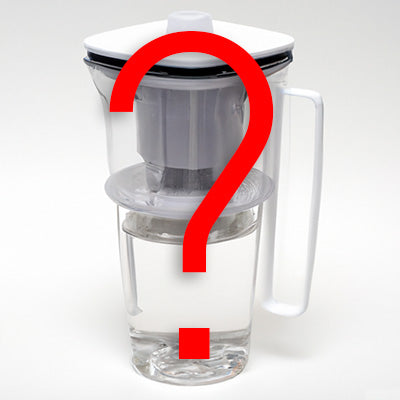
You can't filter it out with conventional filters like a Brita. Technically, at-home reverse osmosis systems exist, but they're expensive and often unnecessary. You also can't simply boil water to remove salt. Larger-scale reverse osmosis filters are being sent to some water treatment facilities to help them maintain clean drinking water for residents. Reverse osmosis units push water through a very thick filter with tiny holes using extremely high pressure to separate the salt. Most homes don't have the ability to push water at that high of pressure.
Salt water is corrosive. How could this affect waterlines and home appliances?
This is a big question, and the answer will continue to develop. Anecdotally, residents in south Plaquemines Parish have reported problems and costly damage to their home appliances and have attributed it to salt water, according to Harvey. They dealt with weeks of exposure to salt levels at 1,600 ppm, more than six times higher than the standard for salt in drinking water. Harvey said Plaquemines is looking into whether a new disaster declaration issued by the Federal Emergency Management Authority will allow residents to apply for money to help with repairs. The current guidance from the Louisiana Department of Health recommends calling your appliance manufacturers for advice.
Corrosion of water lines remains a serious concern depending on how long the salt water sticks around. New Orleans alone has about 50,000 lead pipes still in use, according to Mayor Latoya Cantrell, and salt water could cause those pipes to leach heavy metals. Nguyen said New Orleans and Jefferson Parish are also working with the Louisiana Department of Health to craft a daily monitoring plan and “a robust corrosion detection and public notification plan.” Those will be developed in the coming weeks.
The river is low. Can I take a swim?
Though the river level is low, no one should try to wade or swim in the Mississippi River. Boyett, with the Corps, said while the river's surface might appear calm right now, the current is still violent underneath due to the river's uneven bottom. It's also still very deep, at least 50 feet deep in a lot of places. Near Algiers, it's 190 feet deep. It is not safe for swimming.
Can I garden with the water?
Most plants can handle water with a salinity up to 1,000 ppm, according to the LSU AgCenter. But salt can build up in the soil if there isn't rain to flush it out. Read more here.
How much rain is needed to push the saltwater wedge back?
Col. Cullen Jones, the Corps' New Orleans District commander, has said we need 10 inches of rain to fall across the Mississippi River basin to boost the river, and it would still take time for that water to make its way down south. It would take another 4 to 6 weeks for that water to make it to the mouth of the Mississippi.
How often should we expect this type of saltwater intrusion moving forward?
Researchers don't know exactly how often we can expect this level of saltwater intrusion to happen in the future. Tulane University Bywater Institute Director John Sabo said this has the potential to happen more frequently, in part due to sea level rise and the worsening droughts that have resulted from human-caused climate change, among other factors, but the saltwater wedge shouldn't be considered a “new normal.”
He said that more frequent intrusion does, however, call for long-term adaptation measures to ensure localities in southeast Louisiana aren't scrambling if this happens again.
What's the Solution?
Reverse osmosis (RO) is a water purification process that removes impurities, including salt, from a water supply. It works on the principle of selective permeability and uses a semi-permeable membrane to separate the dissolved salts and other contaminants from the water. Here's how the reverse osmosis process removes salt from water:
- Semi-Permeable Membrane: At the heart of the reverse osmosis system is a specialized semi-permeable membrane. This membrane has very tiny pores or holes that are only large enough to allow water molecules to pass through while blocking larger ions, molecules, and contaminants like salts, minerals, and impurities.
- Pressure: To drive the water through the semi-permeable membrane, a significant amount of pressure is applied to the incoming water. This pressure is usually generated by a pump in the RO system. The pressure is essential because it helps overcome the natural osmotic pressure that tends to push water towards the more concentrated solution (higher salt concentration) on the other side of the membrane.
- Separation of Water and Salts: As the pressurized water is forced through the semi-permeable membrane, only the water molecules can pass through. The larger salt ions, minerals, and contaminants are too large to fit through the tiny pores of the membrane. Therefore, they are effectively blocked and remain on one side of the membrane, typically referred to as the "reject" or "concentrate" stream.
- Pure Water Output: On the other side of the membrane, the purified water, known as the "permeate" or "product" stream, flows through. This purified water is free from most salts, minerals, and contaminants and is collected for use as clean drinking water or for various other applications.
- Waste Disposal: The rejected salts and impurities that couldn't pass through the membrane are typically flushed away as a waste stream. This helps prevent the accumulation of concentrated salts on the membrane surface, which could reduce its efficiency over time.
- Final Treatment: In some cases, post-treatment measures may be applied to the purified water to ensure it meets specific quality standards or to adjust its taste or mineral content. These treatments can include adding minerals back to the water or adjusting the pH level.
Reverse osmosis is an effective method for desalination and water purification, making it suitable for various applications, including producing drinking water from seawater, treating brackish water, and removing impurities from tap water. However, it's important to note that while RO is highly efficient at removing salts and many contaminants, it may not eliminate all types of impurities, and additional water treatment processes may be required in certain cases.
So, if you have water with significant sodium levels and a TDS (Total Dissolved Solids) level of up to 2500 ppm, then reverse osmosis is ultimately the ONLY solution to solving this saltwater intrusion. If you have levels higher than 2500 TDS then it takes a different type of reverse osmosis system. That is called a brackish RO system. However, most saltwater wedges and intrusion are below 2500 TDS. In fact, many are below 1000 TDS.
LET THE BUYER BEWARE - There are many companies selling reverse osmosis systems and the quality of many of these is in question. By nature, a reverse osmosis system should be designed as a heavy-duty commercial product… many are not! Let me explain why. At US Water Systems we have a number of reverse osmosis systems for applications from residential to light commercial and up to industrial size. Let's look at a few:
US Water Systems Reverse Osmosis Lineup


Designed for under sink drinking water applications only for TDS up to 1000. Typically for applications of a few gallons a day. This would not be for a whole house application. Does not use electricity or have a pump.
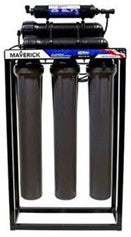

Engineered for light duty applications, such as a lab, beverage service, or a laboratory - for TDS up to 1000. Typically for applications of a hundred or so gallons a day. This would not be for a whole house application. It does use a diaphragm pump which is for very light applications.
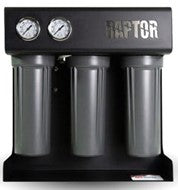

Like the Maverick, the Raptor is engineered for light duty applications, where a countertop system is needed - for TDS up to 1000. Typically for applications of a hundred or so gallons a day. This would not be for a whole house application. It does use a diaphragm pump which is for very light applications.
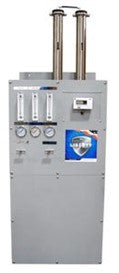

The Liberty RO System is engineered for a little heavier duty applications, where a higher volume of water is needed - for TDS up to 1500. It does use a stainless steel rotary vane pump and it could be utilized as a part of small whole house application, but it is not engineered to last for years like our true Whole House RO system.
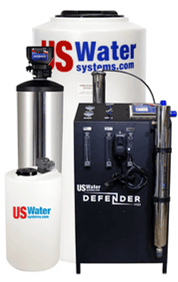

The Defender HD is engineered to be a true heavy duty whole house RO system. It uses stainless steel membrane housings, stainless steel UV, SS reinforced Sch 80 Fittings along with SS threaded fittings. Most importantly it uses a stainless steel centrifugal pump which is manufactured to the most stringent applications. It includes everything necessary for a whole house application, including the tank, carbon filter and anti-scalant. It also has DOUBLE the warranty of any other whole-house RO system.
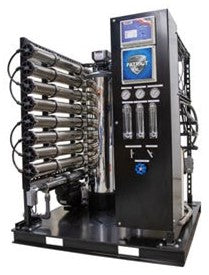

The Patriot XL is a true Plug n Play commercial reverse osmosis system which produces up to 20,000 gallons of pure water each day (larger and smaller sizes are available upon request). The Patriot XL is configured for municipal water that contains chlorine and/or chloramine, but can be custom-configured for well with site specific needs, including iron, sulfur, arsenic, nitrate, boron, manganese and numerous other contaminant removal. Each RO System is custom-engineered based upon site specific applications, and existing water chemistry.
US Water Systems manufactures these high quality Reverse Osmosis Systems in our Indiana plant and our quality is uncompromised. If you are seriously looking at whole house reverse osmosis, the you need to comprehend that a reverse osmosis system with a diaphragm pump or a rotary vane pump is not a viable system and has no longevity.
If you are dealing with salt water intrusion then there really is only one type of pump that really suits that application: A Stainless Steel Multi-Stage Centrifugal Pump! Why stainless steel? Well, most pumps are bronze and bronze is subject to corrosion from the salty water.
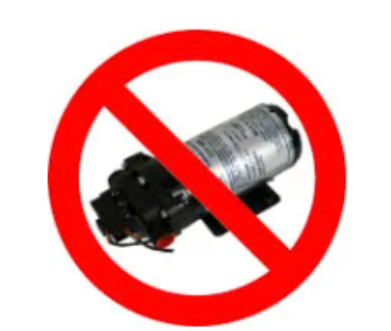
Diaphragm Pump
Light duty pump for intermittent applications. commonly used for under-sink RO applications.
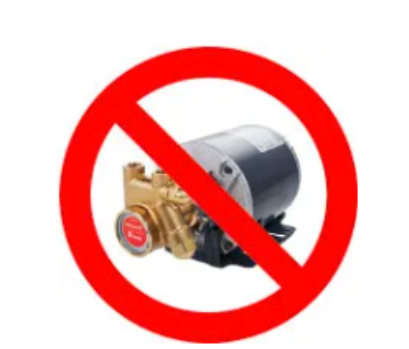
Rotary Vane Pump
Standard pump for residential RO applications where continuous operation is not needed.
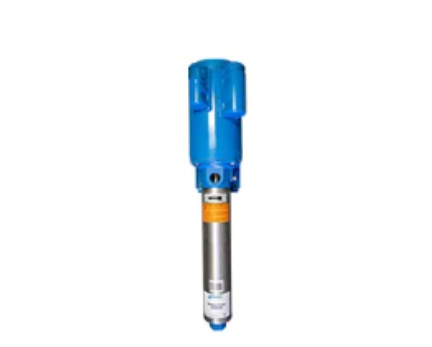
Multi-Stage Centrifugal Pump
Heavy-duty, stainless steel commercial grade pump engineered for continuous operation over a long period of time.
Occasionally, if the TDS gets too high (typically over 3000 or more) we use what is called a “Brackish RO System” which is engineered for even higher TDS levels. This is generally not something that is needed in cases of salt water intrusion or a “salt water wedge”.
Not only can a home reverse osmosis system protect your home's appliances and plumbing against salt water intrusion and corrosion, but since “reverse osmosis removes the largest spectrum of contaminants” of any water treatment process, you can rest assured that other contaminants such as PFOA/PFAS, Arsenic, Cryptosporidium (there has recently been an outbreak of this in Baltimore), and a plethora of others will be removed from your water supply.
So, this begs the question, “Isn't reverse osmosis wasteful?” Before I answer that, what is wasteful and reckless is millions or billions of plastic water bottles flooding our rivers and oceans and the resultant “microplastics” found in almost everything. It is reckless, unsustainable, and extremely damaging to the environment to continue to pretend that these plastic water bottles somehow make things better. NGOs and disaster relief “humanitarian” groups routinely send in these water bottles when it is deemed that some type of disaster is in progress. They men well, but in reality, they are doing more damage than good.
The world's oceans, spanning an expansive 140 million square miles, face an alarming plastic pollution crisis. This issue extends beyond the expected urban coastal areas to remote regions and even the deepest sea trenches. Approximately 11 million metric tons of plastic enter the ocean annually, equivalent to a garbage truck worth every minute. Projections indicate this could increase to a staggering 29 million metric tons per year by 2040 without substantial intervention. Existing efforts, such as banning plastic bags and straws, are insufficient to address this mounting problem. To combat ocean plastic pollution effectively, we need comprehensive, large-scale initiatives involving governments and businesses of all sizes.
One challenge in raising awareness about ocean plastic pollution is that most people cannot visually perceive its extent. Even on a seemingly pristine beach, the pervasive pollution beneath the surface and the trillions of microplastic particles, originating from sources like vehicle tires and textiles, often go unnoticed.
Our society is deeply entwined with plastic, which is omnipresent in our homes, vehicles, personal belongings, and more. The scale of plastic consumption is staggering, with global purchases of one million plastic bottles every minute. Moreover, plastic has found its way into our bodies, impacting our food, water, and air. Recent research even found traces of plastic in human placenta, raising concerns about its long-term health effects.
Recycling has been seen as a solution, but only 9% of plastic worldwide reaches recycling facilities. Many types of plastic pollution, including microplastics, are economically unviable to recycle. Microplastics, in particular, pose a significant threat to marine life as they resemble fish eggs and other small organisms.
Solutions and the Path Ahead:
The report "Breaking the Plastic Wave" highlights that humanity can reduce plastic flow into the ocean by up to 80% by 2040 through concerted efforts by governments and industries. While there are no quick fixes, with sustained and widespread commitment, the ocean plastic problem can be resolved within a generation if we start now! The first step is to cut-down immensely on these microplastics.
A home reverse osmosis system helps you do just that and while older reverse osmosis systems used to be wasteful, newer systems are up to 75% efficient. That means that they waste just one gallon of water for every four gallons they make… and if you want to be super-efficient, that 255 can be recaptured and used to flush toilets and other utility and rinsing processes.






Leave a comment
Please note, comments need to be approved before they are published.